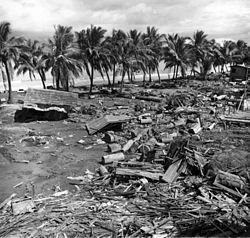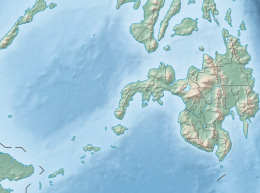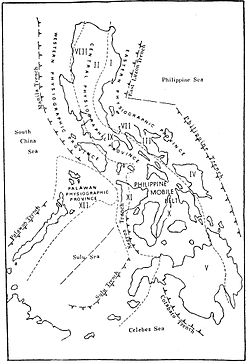1976 Moro Gulf earthquake
 Tsunami damage at Lebak, Mindanao | |
| UTC time | 1976-08-16 16:11:08 |
|---|---|
| ISC event | 709878 |
| USGS-ANSS | ComCat |
| Local date | August 17, 1976 |
| Local time | 00:11:07 |
| Magnitude | 8.0 Mw[1] |
| Depth | 59 km (37 mi)[1] |
| Epicenter | 6°17′N 124°05′E / 6.29°N 124.09°ECoordinates: 6°17′N 124°05′E / 6.29°N 124.09°E[1] |
| Type | Megathrust |
| Areas affected | Philippines |
| Max. intensity | [2] |
| Tsunami | 4–5 m (13–16 ft) |
| Casualties | 5,000–8,000 killed
10,000 injured 90,000 homeless |
The 1976 Moro Gulf earthquake and tsunami took place on August 17, 1976, at 00:11 local time near the islands of Mindanao and Sulu, in the Philippines. Its magnitude was calculated as being as high as 8.0 on the moment magnitude scale.
It was the deadliest and strongest earthquake in the Philippines in 58 years since the 1918 Celebes Sea earthquake.
Tectonic summary[edit]

Several fault zones in the region are capable of producing major earthquakes and destructive local tsunamis. The two major fault zones that are most dangerous are the Sulu Trench in the Sulu Sea and the Cotabato Trench, a region of subduction that crosses the Celebes Sea and the Moro Gulf in Southern Mindanao. According to the PHIVOLCS historical catalog of earthquakes for the last 100 years, this region of the southern Philippines is characterized by moderate to high seismicity. The most recent earthquake along the Cotabato Trench region of subduction being the March 6, 2002 earthquake in Southern Mindanao.[citation needed]
Intensity Report[edit]
| Intensity
scales |
Location |
|---|---|
| VII | Cotabato City; Jolo-Sulu; Zamboanga City |
| VI | Basilan City; Pagadian City; Dipolog City; Malaybalay-Bukidnon |
| V | Cagayan de Oro City; Davao City; General Santos City |
| IV | Dumaguete City; Hinatuan Surigao del Sur; Tagbilaran-Bohol; Cebu City; Surigao-Surigao del Norte |
| II | Roxas City; Iloilo City; Tacloban City; Legaspi City; Palo-Leyte; Catbalogan-Samar |
Effects[edit]
The initial earthquake was widespread and was felt as far as the central Philippine islands of the Visayas. A massive tsunami devastated 700 kilometers of coastline bordering the Moro Gulf in the North Celebes Sea, resulting in destruction and death in the coastal communities of the Sulu Archipelago, southern Mindanao particularly the provinces of Sultan Kudarat and Sarangani (formerly part of South Cotabato), and in the Zamboanga Peninsula including Zamboanga City and Pagadian City.[citation needed]
The maximum height of the waves reached 9 meters at Lebak on the isla; 4.3 meters at Alicia; 3 meters at Resa Bay on the eastern coast of Basilan; and at the islands of Jolo and Sacol.[4] At least 5,000 people died during the earthquake and tsunami, with thousands more remaining missing.[5] Some reports say that as many as 8,000 people lost their lives in total, with ninety percent of all deaths the result of the following tsunami.
Initially over 8,000 people were officially counted as killed or missing, 10,000 injured, and 90,000 homeless, making it one of the most devastating disasters in the history of the Philippine Islands.[6] After the initial earthquake the people were unaware of the need to move to higher ground; when the tsunami hit it sucked most of the victims out to sea.[6] Based on the investigation on the affected region it was confirmed that the waves reached up to 4 to 5 metres (13 to 16 ft) when they hit the areas. There were reports of weak tsunami activity as far as Japan.[6]
In Zamboanga City, 14 buildings were partially damaged. Zamboanga City was spared from serious damage of the tsunami triggered by this earthquake because the Basilan Island and the Santa Cruz Islands served as a buffer and deflected waves.[7]
See also[edit]
References[edit]
- ^ a b c Engdahl, E. R.; Vallaseñor, A. (2002). "Global seismicity: 1900–1999" (PDF). International Handbook of Earthquake & Engineering Seismology. Part A, Volume 81A (First ed.). Academic Press. p. 683. ISBN 978-0124406520.
- ^ Philippine Institute of Volcanology and Seismology (2018). "PHIVOLCS Earthquake Intensity Scale (PEIS)". Retrieved November 13, 2019.
- ^ Looking Back: What Filipinos learned from the 1976 Moro Gulf Earthquake? whatalife.ph
- ^ Department, Commerce; Dunbar, Paula K. (24 April 2015). Pacific Tsunami Warning System: A Half Century of Protecting the Pacific, 1965–2015. Government Printing Office. pp. 46–47. ISBN 978-0-9962579-0-9. Retrieved 22 August 2017.
- ^ History of Tsunami Devastation
- ^ a b c Staff of the Academy of Sciences of the USS (1997). Catalog of Tsunamis in the Pacific 1969–1982. Diane Pub. pp. 103, 104. ISBN 978-0-7881393-1-4.
- ^ "Moro Gulf Earthquake – 17 August 1976". Philippine Institute of Volcanology and Seismology. Archived from the original on 2013-10-15. Retrieved 2013-10-15.
External links[edit]
- Philippines Institute of Volcanology and Seismology Archived 2010-01-29 at the Wayback Machine
- The Earthquake and Tsunami of August 16, 1976, in the Philippines – The Moro Gulf Tsunami" – George Pararas-Carayannis
- The International Seismological Centre has a bibliography and/or authoritative data for this event.
- Articles with short description
- Short description with empty Wikidata description
- Articles using Mw magnitude scale
- Coordinates not on Wikidata
- All articles with unsourced statements
- Articles with unsourced statements from March 2022
- Webarchive template wayback links
- Megathrust earthquakes in the Philippines
- 1976 in the Philippines
- 1976 earthquakes
- 1976 tsunamis
- History of Zamboanga del Sur
- History of Maguindanao



